Name That Plant, Win That Plant XV Answer: Roselle
Roselle, Hibiscus sabdariffa
 Who wants tea? Not only is the roselle a pretty plant with cranberry red stems and fall season blooms, but the dried flower can be used to make tea. Also, at the base of each flower is the calyx, which is harvested about 10 days after the bloom opens for use in teas, juices, and jellies. Like many hibiscus, the roselle, sometimes called Florida cranberry, has several medicinal properties and it’s used in herbal products.
Who wants tea? Not only is the roselle a pretty plant with cranberry red stems and fall season blooms, but the dried flower can be used to make tea. Also, at the base of each flower is the calyx, which is harvested about 10 days after the bloom opens for use in teas, juices, and jellies. Like many hibiscus, the roselle, sometimes called Florida cranberry, has several medicinal properties and it’s used in herbal products.
 Native to Africa, roselle does well in South Florida and is rated for zones 8 and higher. It is an annual that can regrow easily from seed. In zones 10 and 11 roselle may even survive a few years if the winters are mild. The plant will continue to produce flowers during October and November as long as the flowers are harvested regularly. False roselle, H. acetosella, is similar to roselle but has maroon-colored leaves. Both species may sucker and can reach ten feet or more if not kept pruned.
Native to Africa, roselle does well in South Florida and is rated for zones 8 and higher. It is an annual that can regrow easily from seed. In zones 10 and 11 roselle may even survive a few years if the winters are mild. The plant will continue to produce flowers during October and November as long as the flowers are harvested regularly. False roselle, H. acetosella, is similar to roselle but has maroon-colored leaves. Both species may sucker and can reach ten feet or more if not kept pruned.
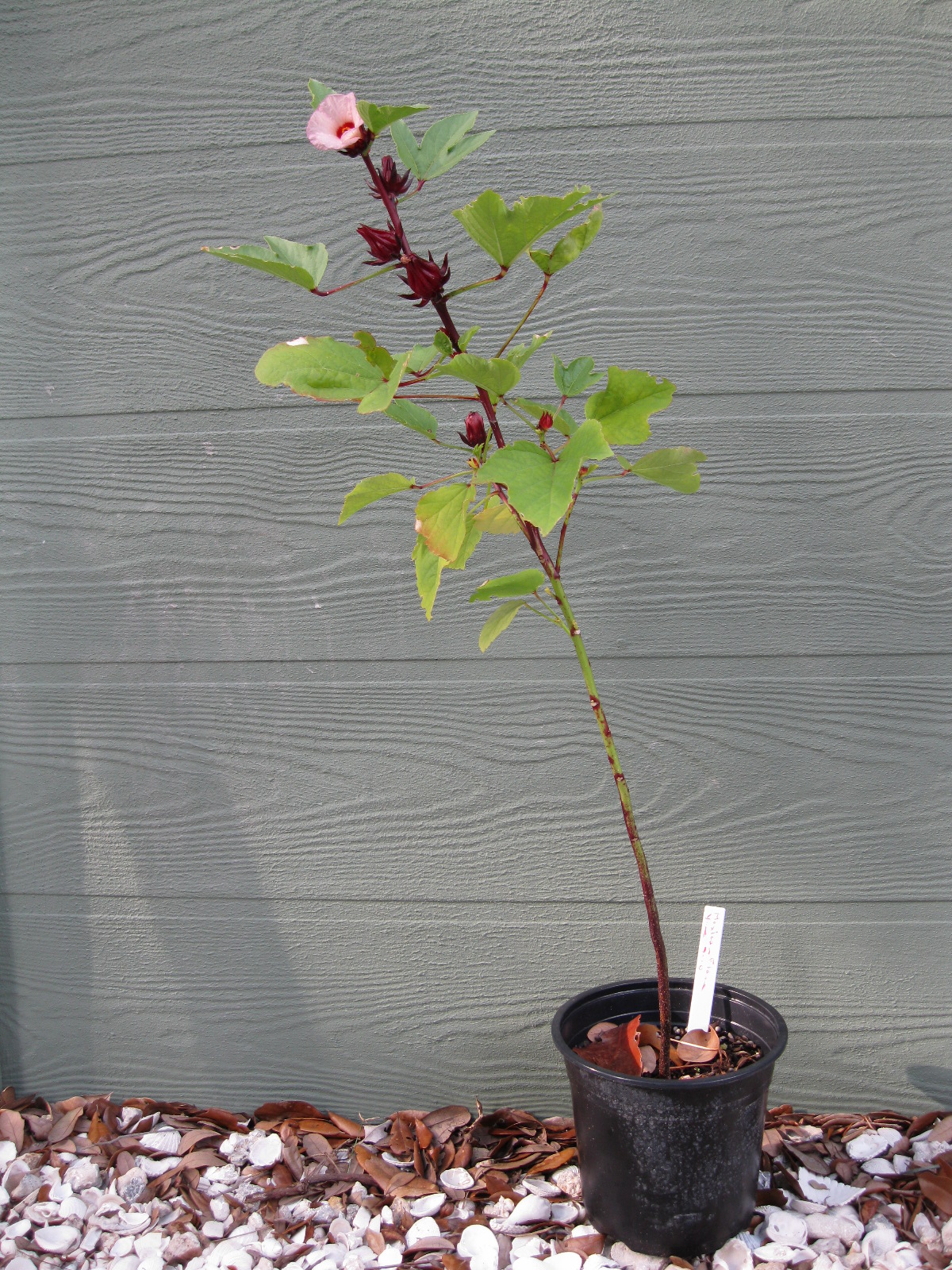 You can find numerous recipes online that incorporate roselle. Do any of you have a favorite roselle recipe to share?
You can find numerous recipes online that incorporate roselle. Do any of you have a favorite roselle recipe to share?
We have a few roselle plants for sale in the Estates Garden Shoppe for just $4 – most are blooming and ready for your recipes! If you buy yours before November 1, you can save 10% on ALL your Garden Shoppe purchases by telling the cashier the secret discount phrase.
Halloween-ish Plants, Part 2
Following my report on the zombie palm, here’s another plant at the Estates with a creepy name: DEVIL TREE, Alstonia scholaris.
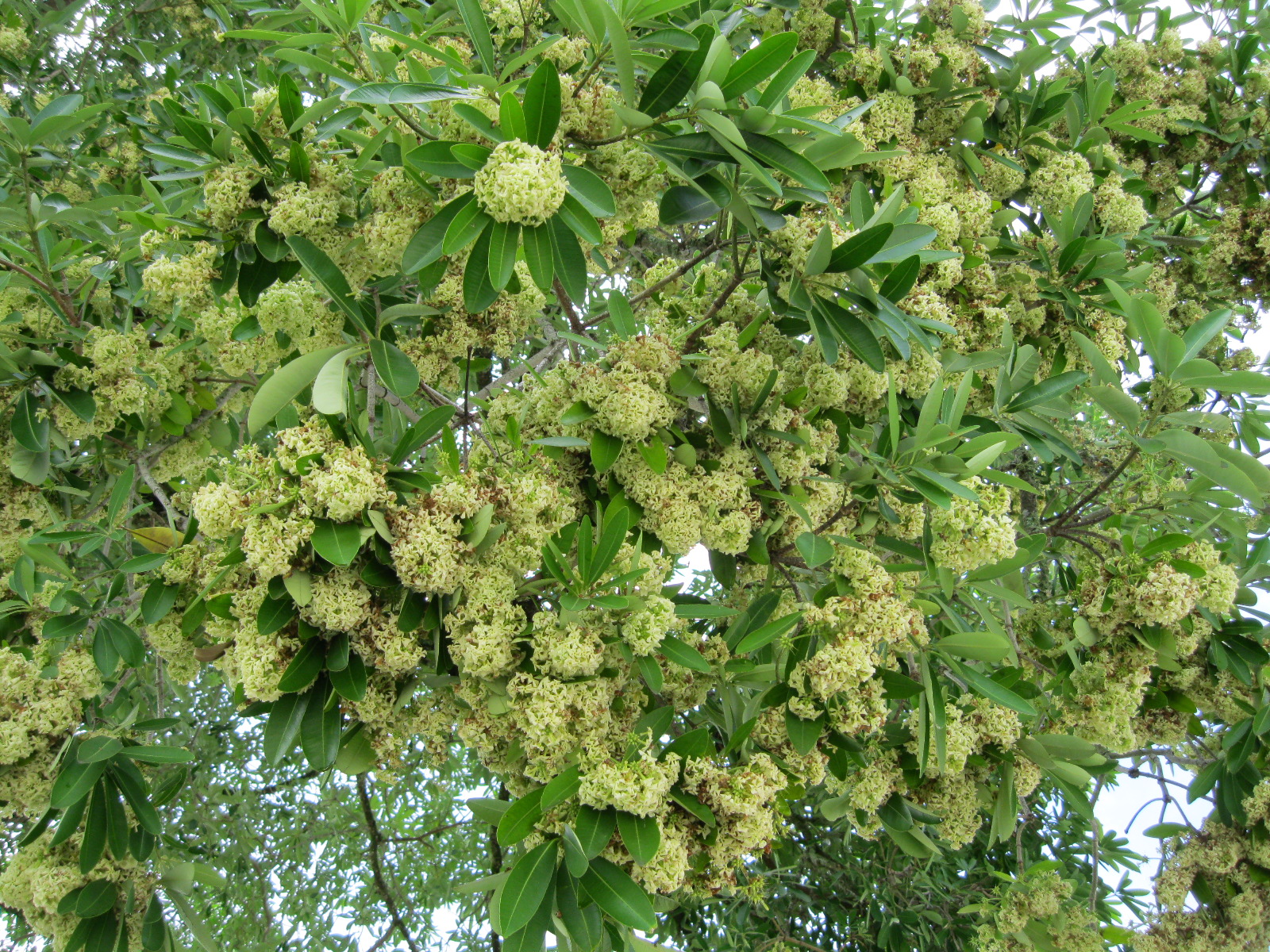 Like most common names, it’s hard to pinpoint how the name came about. Some say it’s because the seedpods, which hang down in long thin bunches, resemble a devil’s pitchfork. Some cultures believe the devil or ghosts live in the tree. Others say it is because the flowers smell so sweet they entice passers-by to lay under tree, only to be lulled into eternal sleep.
Like most common names, it’s hard to pinpoint how the name came about. Some say it’s because the seedpods, which hang down in long thin bunches, resemble a devil’s pitchfork. Some cultures believe the devil or ghosts live in the tree. Others say it is because the flowers smell so sweet they entice passers-by to lay under tree, only to be lulled into eternal sleep.
Although the common name’s origins are not understood, its scientific name is quite clear. The genus Alstonia, which includes at least 40 species of trees, all called devil trees, was named after Charles Alston, a professor of botany in Scotland during the early 1700’s. The species name scholaris refers to the historic use of the timber as blackboards and slates for school children.
 Since it prefers warm temperatures (it is native to southeast Asia and Australia), our devil tree grows readily at the Estates. It is at the east end of the main parking lot.
Since it prefers warm temperatures (it is native to southeast Asia and Australia), our devil tree grows readily at the Estates. It is at the east end of the main parking lot.
Don’t forget: Garden Blog readers can save 10% on all Garden Shoppe purchases by telling the cashier, “Watch out, there’s a zombie palm behind you!” This offer is only good through Oct 31, 2010. We may not offer a discount next month, so if there’s a gardening book, an orchid, a citrus tree, or butterfly plant you’ve had your eye on, hurry in to use your discount!
Britta Soderqvist, Plant Curator
Name That Plant, Win That Plant XV
Be the first to identify this plant and win that plant or a peace lily! The correct answer will be announced Wednesday, October 27. We’ve made this one challenging and if no ones guesses correctly in the next few days, we’ll reveal a little more of the picture.
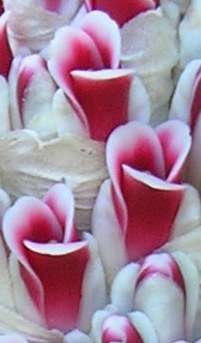 Contest Rules: Leave a comment on Facebook or the Garden Blog with your answer. The person with the first correct answer may choose to receive the mystery plant (if available) or a peace lily. The winner will be announced on the Estates Garden Blog and on Facebook. Plants must be picked up from the Edison and Ford Winter Estates within 7 days of contest end (and, no, we can’t ship them!). If you have won previously, please wait 60 days before guessing again.
Contest Rules: Leave a comment on Facebook or the Garden Blog with your answer. The person with the first correct answer may choose to receive the mystery plant (if available) or a peace lily. The winner will be announced on the Estates Garden Blog and on Facebook. Plants must be picked up from the Edison and Ford Winter Estates within 7 days of contest end (and, no, we can’t ship them!). If you have won previously, please wait 60 days before guessing again.
UPDATES: October 21: No one has guessed our mystery plant, so here’s another piece of the puzzle. October 22: We have this plant for sale in our Garden Shoppe right now. October 27: Here’s a wider shot of the Oct 21 update that includes the leaves (hint, hint).

What's Blooming at the Estates
Your opinion is valued! Please take our short 5 question survey to help us make this blog better. And don’t forget the special discount for Garden Blog readers on all Garden Shoppe items this month!
Name That Plant, Win That Plant XIV Answer: Desert Rose
Desert Rose, Adenium obesum
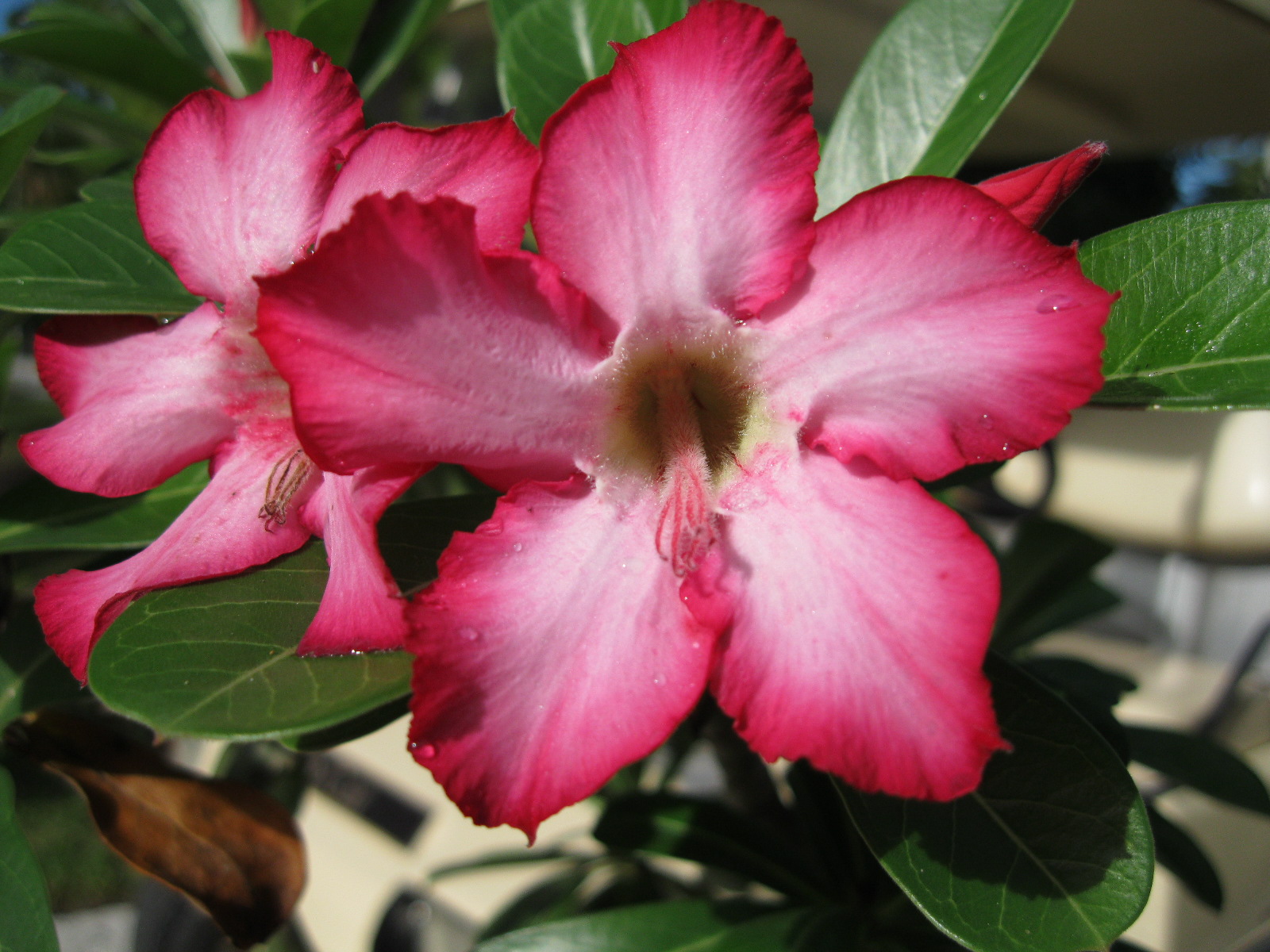 Don’t let this plant’s common name fool you. It is not a “rose” and although native to sub-Saharan Africa and the deserts of the southwestern tip of the Arabian Peninsula, this interesting plant grows well in South Florida’s humidity. It has a beautiful bright red, pink and white flower, but many enthusiasts grow desert rose for the caudex, or base, which can be manipulated to form unique shapes.
Don’t let this plant’s common name fool you. It is not a “rose” and although native to sub-Saharan Africa and the deserts of the southwestern tip of the Arabian Peninsula, this interesting plant grows well in South Florida’s humidity. It has a beautiful bright red, pink and white flower, but many enthusiasts grow desert rose for the caudex, or base, which can be manipulated to form unique shapes.
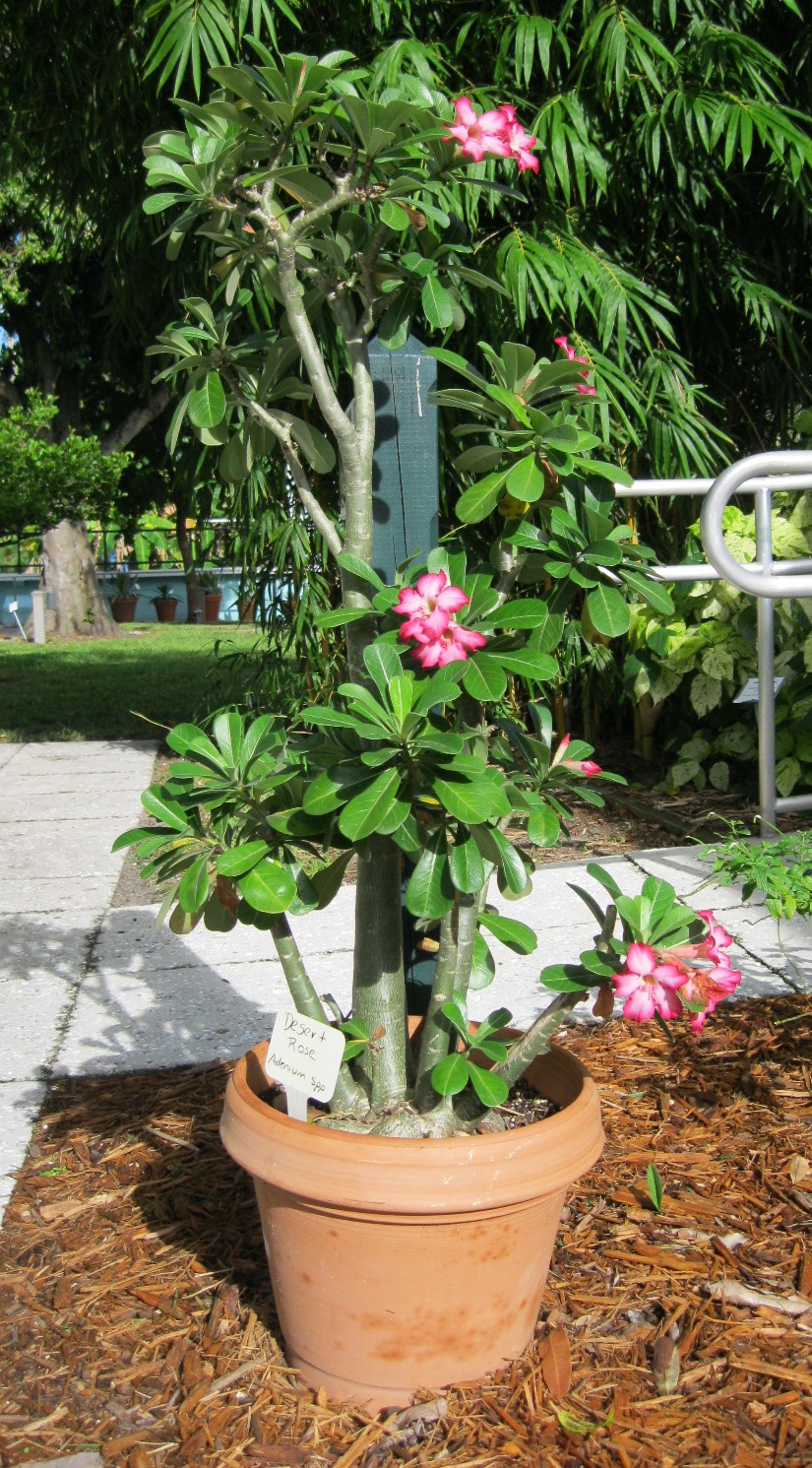 Desert rose is suitable for container gardening or will thrive in your yard if planted in full sun and well-drained soil. Plants should never be in standing water and should not get much water at all in the cooler months, as this species is prone to root rot. If temperatures regularly fall below 35°F in your area, it’s best to grow desert rose in a container so the plant can be moved inside during cold snaps. Leaves may drop during winter but the plant should recover nicely each spring, providing months of beautiful blooms in the summer. All parts of the plant are toxic if ingested and the sap may irritate skin, so use caution when planting.
Desert rose is suitable for container gardening or will thrive in your yard if planted in full sun and well-drained soil. Plants should never be in standing water and should not get much water at all in the cooler months, as this species is prone to root rot. If temperatures regularly fall below 35°F in your area, it’s best to grow desert rose in a container so the plant can be moved inside during cold snaps. Leaves may drop during winter but the plant should recover nicely each spring, providing months of beautiful blooms in the summer. All parts of the plant are toxic if ingested and the sap may irritate skin, so use caution when planting.
We have a desert rose growing in a container in front of the Caretaker’s house at the Estates. We also have several for sale in our Garden Shoppe. Don’t forget, garden blog readers save 10% off their Garden Shoppe purchases by mentioning the phrase of the month at check-out!
Pop Quiz: Vocabulary
This fruit’s name was once used as a verb describing a specific way to preserve food.
Do you know the names of the fruit and the preservation method?
This is just for fun – no prizes, just bragging rights!
UPDATE: The fruit and preservation method are two different words (and the fruit is NOT cucumber).
Halloween-ish Plants (and a discount for zombies?)
During October, I’ll be blogging about plants with creepy names or features to get us in the spirit of Halloween. The first spooky entry: ZOMBIE PALM!
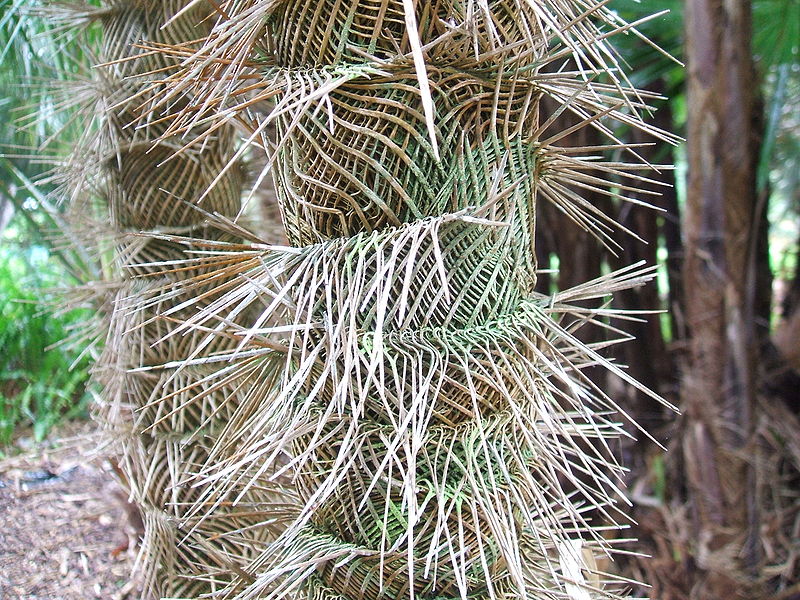 The “zombie” term is probably derived from the plant’s scientific name, Zombia antillarum. Unlike zombies, the palms are firmly rooted into the ground but you still wouldn’t want to get too close! The trunk of mature palms are covered with a dense mat of 3-4” spines.
The “zombie” term is probably derived from the plant’s scientific name, Zombia antillarum. Unlike zombies, the palms are firmly rooted into the ground but you still wouldn’t want to get too close! The trunk of mature palms are covered with a dense mat of 3-4” spines.
This is the only plant within the Zombia genus. So how did the zombie reference originate? Keeping in mind these palms are native to Hispaniola:
“We found that there is indeed a connection between the vernacular name and Haitian culture. According to an ethnographic source, the people of Gros-Morne, Haiti, believe that the yellowish-brown oil produced by the seeds is a “sense-activator” used to stimulate all five senses. They believe this oil can be used to “awaken” a zombi back to life. Another use by Haitian locals, linked to the common name as well, is that the leaves are used as thatch material along rooftops of houses to keep zombies from being posted by their masters in order to spy on people. However, this information could not be verified, as different sources even denied having ever heard of the use of the seeds as a source of oil.” Quoted from the article “Notes on Economic Plants” by F.B. Taylor and J.C. Timyan, Economic Botany 58(2):179-183. 2004.
 Zombie palms are very low maintenance and can be planted as a landscaping tree in southern Florida. They are slow growing and may reach 15 feet at maturity. We have one at the Estates on the Edison property, but it is very young and doesn’t have the spikes yet. If you want to see another species of palm with impressive spikes, visit our macaw palm, Acrocomia aculeata, located between the Caretaker’s House and McGregor Blvd.
Zombie palms are very low maintenance and can be planted as a landscaping tree in southern Florida. They are slow growing and may reach 15 feet at maturity. We have one at the Estates on the Edison property, but it is very young and doesn’t have the spikes yet. If you want to see another species of palm with impressive spikes, visit our macaw palm, Acrocomia aculeata, located between the Caretaker’s House and McGregor Blvd.
While you’re here, be sure to say this month’s savings phrase, “Watch out, there’s a zombie palm behind you!” You can say it to whomever you like (and probably get some funny looks) but if you mention it to the cashier, you’ll receive a 10% discount on all Garden Shoppe items like potted orchids, gardening books, fruit trees, butterfly plants, etc.
Britta Soderqvist, Plant Curator